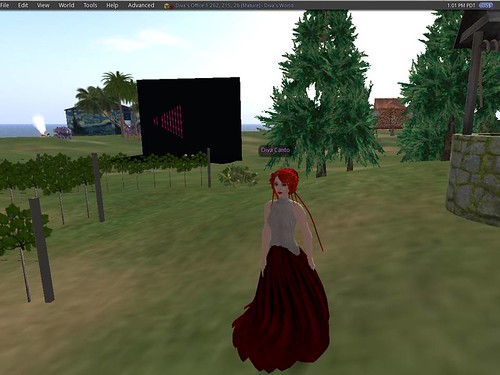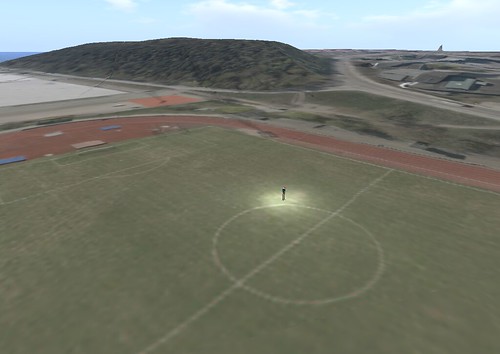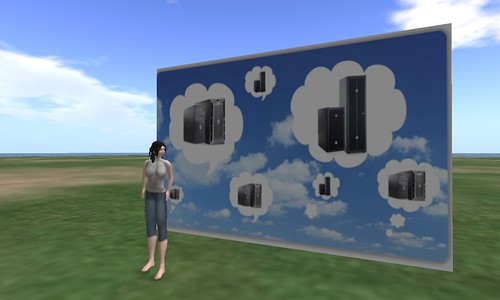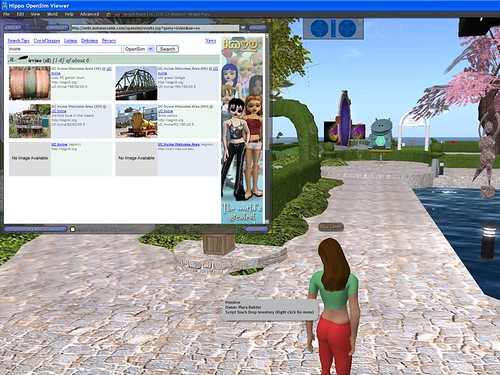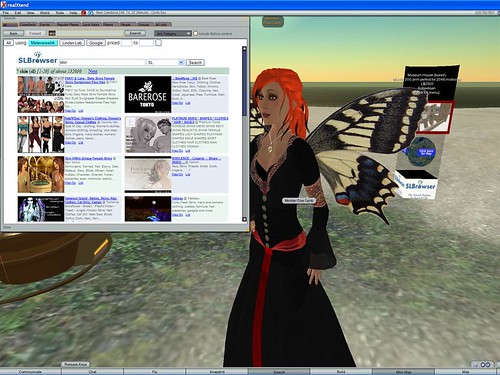It has been a while since I made a D2 + Wifi releases. I had been waiting for OpenSim 0.7.1; the changes between 0.7.0.2 and 0.7.1 were such that I didn’t want to risk making a release in between. OpenSim 0.7.1 finally happened earlier this week, so here is the much awaited D2! Technically, it corresponds to OpenSim r15402, which is a couple of commits after the official release — I found a couple of bugs in the official release related to the Library, so I fixed them.
Tag Archives: OpenSim
A Tour Through Unity3D for SL/OpenSim Aficionados
I was sick-ish last week, so I decided to use my idle cycles to finally learn Unity3D. I thought I’d share my impressions, given that (a) I’m not a 3D modeler, not even an amateur one, and (b) my only experience with 3D environments has been Second Life / OpenSim. I suspect there are lots of people like me. Being an OpenSim aficionada, and fairly ignorant of everything else (mainly for lack of time), I always felt like I was missing the big picture. Indeed, I was, and I’m glad my cold last week gave me the opportunity to explore a completely different point of this large design space. The picture above shows one of the environments I created. The bottom line, if you don’t care to read more, is this: the Unity3D ecosystem feels like Second Life for grown ups.
Sculpt Terrains
I do a fair amount of work with people in urban planning. Realism in those virtual environments is the starting point for the imagined plans they have in mind. The very first thing they want is the realistic terrain of the area. It has proven difficult to get the elevation data of specific areas, but we always end up finding it in some obscure place or other. Unfortunately, the terrain by itself doesn’t quite give the feel of the area as it exists today. Instead, it gives the feel of the area as it might have existed 10,000 years ago! — no signs of human civilization. Which, as nice as that may be, doesn’t quite do the job for urban planning. This weekend I was finally able to generate realistic terrains in OpenSim overlayed with a realistic image. Here is the story.
The Cloud vs. The Home
For the past couple of months I’ve been flirting on and off with Amazon Web Services (AWS). This past summer my students started using it in some of our research projects, so I had to catch up with them. Those projects have nothing to do with OpenSim, but I made my own learning plan focused on getting an OpenSim instance to run in the cloud.
Diva Distro for 0.7: Introducing Wifi
It took a long time, but OpenSim 0.7 is finally here! It’s quite difficult to explain the value of refactorings and of re-conceptualizations of the software, which is what happened to OpenSimulator between 0.6.x and 0.7. Those things tend to be intangible at first (“WTF? This does the same thing! And it has bugs that it didn’t have before!”, etc.); the ROI only shows up later.
Thank you, Lindens

Yesterday, Stefan wrote down his thoughts on Linden Lab’s troubles. I loved that post, he’s right on. Let me add to that by stating the importance of the work that many of the laid off Lindens did, and the role of OpenSimulator from here on, at the technological level and beyond.
Things are moving into 3D, including the Web. I’ve been very excited with everything that is going on with WebGL. Sure, WebGL is still not good enough to render very rich scenes like those we find in highly immersive games, especially when the scenes aren’t optimized, such as the case with user-generated 3D content. But I have very little doubt that the needed optimizations will happen, and that soon we will have immersion on the web browser. It’s already happening. People want it, Google wants, it will happen.
So, let’s fast forward to the time when the Web browser can render rich 3D scenes, which, at the rate that the Google people and the Unity3D people are going at it, it probably is only a couple of years away.
90-Degree Course Adjustment

The news came yesterday after lunch: major layoffs at Linden Lab, as much as 30% of their employees. Lindens who had been there from early on, respected engineers, all laid off. All of those who had, at some point, been involved in the idea of virtual world interoperability — gone. Then the new vision: Second Life on a browser, accessible to the masses via well-known social networks. Wow. This is what I call a 90-degree course adjustment.
Clearly, I know nothing about the internal situation at Linden Lab. Probably their VC money has dried off, maybe their revenue is not enough to pay so many people. Who knows what’s behind a 30% ‘rightsizing’… But the new vision is an indication that this is not just about balancing the budget sheet; it’s about redefining what Second Life is. LL’s CEO wants it to be more like FarmVille than like World of Warcraft. Too many people have commented on his vision, I’m not going to do it. He’s the head of the company, he should try to make his vision come to life.
What I want to talk about here is what this 90-degree course adjustment entails for OpenSim. I confess yesterday I had that familiar feeling of having reached the point of having to stand and lead. Not me, personally. But the OpenSim project, as a whole. The torch is on us. Let me explain.
Metaverse Ink Search for OpenSims
You knew this was coming, and here it is: Metaverse Ink Search is now serving OpenSims around the world! This has been in the works for a while — in fact, it has been working for a while — but we kept it under wraps. A month ago or so, Eric Reuters wrote an article about it, but we still didn’t say much of how this whole thing works for OpenSim. This post explains it.
We worked with the OpenSim project in implementing the basic plumbing for search engines to operate in virtual worlds. We think this basic plumbing is the right support for searching virtual worlds, be them closed or open to the world wide web, and we are happy to see the grid-wide search project now using this same basic plumbing. The fundamental design philosophy is that the region’s data exposure to clients other than the viewer is a decision that involves 3 authorities: grid operators (if regions are connected to grids), region administrators, and parcel owners/content producers:
- Grid operators decide whether the grid is to be closed or open, and the amount of openness. For closed grids, their data should be off-limits to external search engines like MI Search, just like the data in Bank Of America is off-limits to Google. This can easily be achieved by setting region configuration variables appropriately. Those configuration variables can be set so that only a grid-wide search engine can access the regions’ data.
- For open grids and standalone sims, region administrators decide whether to expose the data, the level of data exposure, and *which search engines can access it*. This last part makes virtual world search subtly different from web search, and for the better. On the web, search engines find web servers, and their pages, by following hyperlinks. All data reached is assumed to be public and, as such, indexable. This has caused a lot of pain on the Web, so let’s not go there. The idea here is that region administrators decide who indexes their data, and how much data is exposed to them. Data can be exposed to one or more virtual world search engines.
- Finally, parcel owners and content producers decide what data is intended to be found by checking the “show in search” check box in parcels and objects. In OpenSims, that checkbox tends to be free of charge.
All this is accomplished by configuring a core module of OpenSim called DataSnapshot. The configuration is done in OpenSim.ini, in the section pertaining to the DataSnapshot module, and it allows the variety of behaviors described above. So if you want the searchable data in your region listed with MI Search, go ahead and configure OpenSim.ini for it.
A second optional module deals with serving images (see how it looks here). This module, called ImageService, is a region module that extends regions with the ability to serve images onto the Web, so that explicitly marked, rich 2D content can be shared within a grid and/or with the whole world. The only images served are those whose keys are exposed via the DataSnapshot module, i.e. images related to things marked for search. That way we avoid exposing the entire collection of textures stored on the grid/asset server. The ImageService module is available from OpenSim’s GForge. If you want MI Search to show pictures of your wonderful regions, go ahead and place the dll of the ImageService in your OpenSim/bin directory.
The DataSnapshot module has been part of OpenSim since April 2008; the ImageService is our latest addition. OpenSim region operators have been able to figure it out, even though there were no announcements whatsoever. So much so, that we now have hundreds of regions on our opensim index in a variety of places, grid-ed and standalones. We are really excited to provide the first glimpse of the emerging Virtual World Web!
realXtend: a major step forward
We’re delighted to announce that Metaverse Ink’s OpenSearch has been selected as the default interface for search in the new viewer realXtend, whose 0.2 release was announced today. The realXtend project has been working closely with OpenSim in order to add some major features to it, both in terms of graphics and in terms of the underlying architecture of virtual worlds. The most important addition is the idea of an “avatar system”, a piece of the architecture that sees avatars as entities that can move freely between worlds — not just sims on the same grid, but sims on different grids. An avatar has an identity and an inventory, and that’s what’s being served from that component. The avatars themselves can now be created with a standard 3D modeling tool.
We believe that OpenSim, with these realXtend additions and other additions that are already in the making, is the future of interoperable virtual worlds. We are excited to be a part of it!
So, download realXtend, and try it out. Don’t forget to click the Search button and see OpenSearch natively served. Now you have a choice on the search engine you use for each search, just like what happens in modern web browsers.
Happy Searches!

